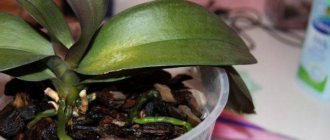We all know about such a beautiful flower as an orchid. But few people realize that the first such flowers could have existed on Earth more than 130 million years ago.
Introduced to Europe 200 years ago, orchids quickly became popular. And now, thanks to the work of botanists, you can find this plant in many homes.
Caring for a flower is extremely complex and requires taking into account many factors. But if you approach this process responsibly, then the orchid will delight you for a very long time.
Creating favorable conditions for the flower
To prevent the orchid from dying a few weeks after purchase, you need to choose the right temperature and provide the necessary lighting.
It is important to create the most favorable conditions for growth for the plant.
How to find out the requirements of an orchid for light?
How to find out whether an orchid requires light, especially if its name or origin is unknown? The plant itself can help here.
Species with hard, leathery, thickened leaves require a lot of light, and if the leaf has a cylindrical cross-section, then perhaps the maximum amount.
A typical example is the genus Vanda. Vandas are very sun-loving, but one of them, Vanda teres, which has cylindrical leaves, is so demanding of light that at the latitude of Moscow it does not bloom every year, but only after a very hot and sunny summer.
Oncidium splendidum, an orchid from Mexico with hard sword-shaped leaves and a small flat bulb, also grows in open areas in direct sun.
Cattleyas and dendrobiums need a little less light
Orchids with bulbs and thin leaves need even less light . These include (as the need for light decreases): catasetums, lycastes, coelogines, calanthus.
Plants with leathery, soft and wide leaves without bulbs and soft-leaved alpine species with bulbs require even less light , these are phalaenopsis, miltonia, odontoglossum.
Orchids with soft, delicate leaves and thin stems - anectochilus, makodes - have the least needs
Appearances can sometimes be deceiving . If you expose catasetum and calanthus, which are similar in appearance, to direct sun, then the former will only benefit from this, and the leaves of the calanthus will quickly burn.
The rosettes of Paphiopedilums, which in appearance are usually placed in the shade, actually require slightly less light than Cattleyas.
The color and structure of orchids is a good indicator of the correctness of the chosen lighting conditions.
Like indicator paper, the color of their leaves changes depending on light conditions.
In a healthy orchid they are bright green. If the leaves darken , the plant clearly does not have enough light; if they turn yellow or take on a reddish tint, there is too much light.
Choosing lighting for a plant
The orchid is a light-loving flower, but it does not require direct sunlight, but soft, diffused lighting. The lack of necessary lighting will lead to a change in the color of the leaves - they will gradually lighten, stretch out, and soon turn yellow.
At the same time, in summer you need to cover the plant from direct sunlight. After all, intense lighting can cause burns. And in the spring, you should gradually adapt the flower to solar radiation using a matte film on the windows or plastic.
In autumn, the darkening can be removed, because solar radiation is no longer too active. And soft sunlight will contribute to better ripening of shoots, better formation of shoots and the transition of the flower to a dormant state.
The climate zone greatly influences the conditions that the plant needs to create. If daylight hours in your area do not exceed 10 hours, then additional artificial lighting using fluorescent lamps is required.
Orchid photosynthesis
The ground part of the orchid (leaves, stem, pseudobulbs, etc.) catch sunlight.
With the help of chlorophyll, they convert it into the energy necessary for plant development, which contributes to the creation of glucose and other organic compounds.
This process is called photosynthesis .
Photosynthesis can only occur under sufficient light conditions.
Insufficient lighting leads to the formation of a smaller amount of glucose, which is insufficient for the normal growth and development of the orchid.
In turn, excessive lighting disrupts the process of glucose formation, leading to leaf burns.
For plants, the intensity and duration of the light falling on them is important.
As the amount of light hitting the leaf increases, the rate of photosynthesis also increases proportionally.
At some point, the plant stops responding to additional lighting, as if becoming saturated.
Each type of orchid has adapted to certain lighting conditions during evolution.
Creating a comfortable temperature regime
To choose the right temperature, it is necessary to take into account the differences in requirements for individual groups of orchids:
Heat-loving flowers (phalaenopsis, dendrobiums) need warm temperatures all year round. Summer mode 15-32 degrees and winter mode 15-18 degrees Celsius are suitable for them. In this case, the temperature difference during the day should not exceed 3-5 degrees.
Medium-temperature orchids (odontoglossums, miltonias) prefer cooler conditions. In summer the temperature should be 18-22 degrees, and in winter – 12-15 degrees.
Cold-resistant plants (Australian dendrobiums, paphiopedilums, laelias) grow at a summer daytime temperature of 22 degrees and with a winter night temperature of 12 to 15 degrees.
Orchid bloom at home
You were given an orchid as a gift and it quickly faded? Almost everyone does. Making an orchid bloom is not an easy task for a novice gardener, as we already know that an orchid is a demanding plant.
Let's take a closer look at what factors determine the frequency of orchid flowering and how to get an orchid to bloom at home.
When purchasing an orchid in a flower shop, ask about its age; usually orchids begin to bloom at the age of 1.5 to 2.5 years.
- The first most influential factor on the flowering of orchids is the length of daylight hours. For each specimen, there is a certain length of daylight hours, which allows for the full formation of peduncles. Compliance with this factor serves as a signal for the formation of flower buds in the orchid. A lot of time may pass between the process of bud formation and the formation of a peduncle; you should be patient.
- The second factor is observing the difference between night and day temperatures. The difference should be in the range from 5 to 7 degrees.
If after this the orchid does not bloom? There are several more ways to make an orchid bloom at home.
- Temperature drop to +16 degrees for two weeks.
- Reducing watering (changing the usual regime).
When you achieve flowering, the orchid will delight you with its beautiful flowers for 2 to 8 months, depending on the type and number of flower buds. During orchid flowering, watering is doubled. After the orchid has finished blooming, collect the dry buds and begin the feeding cycle.
Orchid replanting and pruning
If the old pot has become small or damaged, living roots are intertwined with dead ones, the substrate has become salty or formations have appeared on its surface, then it is necessary to replant the plant.
To do this, you need to carefully remove the orchid from the pot. To avoid damaging the root, it is advisable to cut the container. The roots are cleaned, old and damaged elements are removed with scissors. The root system must be washed with clean water. Then a new composition is poured into the bottom of the new pot.
When the plant is placed in a container, new soil should be poured into the spaces between the roots. The top should not be covered. Then the soil is moistened and placed in the shade for several days.
Pruning of the peduncle should be done at the base or where there were previously flowers. The presence of dormant buds allows you to count on the appearance of lateral peduncles or children.
Remember, if cracks appear in the center of the leaves, this is evidence of sudden temperature changes or damage. Flabby leaves indicate problems with the root system or incorrect temperature, and growths and black spots are sunburn.
When the leaves rot and a silvery cobweb appears on the back side, the problem may be pests. Therefore, it is necessary to use acaricides.
Following the conditions for caring for orchids will allow you to create a blooming garden at home. These plants will delight you with their bright flowers for a long time.
Watering orchids at home
Watering is a predetermining factor for the successful growth and flowering of your beauty. In nature, the vast majority of orchids are not found in water and do not tolerate prolonged stagnation of moisture. Watering orchids at home comes down to creating conditions for the plant that are close to real. To do this, you need to know what species your orchid belongs to. “Phalaenopsis”, “Paphiopedilum”, “Odontoglossum”, “Cymbidium” always prefer a slightly moist, but not wet substrate, but the soil for “Oncidium”, “Dendrobium”, “Cattleya” must be dry before watering.
In addition, the intensity of watering is also influenced by such factors as temperature and humidity, lighting intensity, pot size, substrate composition, and the phase of the seasonal growing season. Orchids are epiphytic plants, so they can tolerate dry soil for a short time. But if you do not water systematically, the orchid’s leaves will begin to wither and wrinkle, and if there is excess watering, there is a high probability of rotting of the root system and the formation of yellowness around the perimeter of the leaf.
It is advisable to water the orchid with soft water. The ideal option would be to pre-settle rainwater in the summer and melt water in the winter. You can also boil tap water. The water temperature for irrigation should be 2 - 3 degrees warmer than the surrounding air. In summer, the orchid is watered 2-3 times a week, when the outer layer of the substrate dries out. In winter, watering is reduced to a minimum of 1 - 2 times a week; a slight wrinkling of the pseudobulb will serve as a signal for watering.
An orchid planted in a pot is watered from above, and in blocks or baskets it is immersed in water for 3 to 5 minutes. In both cases, it is necessary to allow excess water to drain, and in no case allow it to stagnate.
Photos of orchid care
leave a comment
Click to cancel reply.
You must log in to post a comment.
Is it possible to grow an orchid at home and what signs are associated with it?
Despite our enlightened age, superstitions among people are still very common. They apply to everything, including ordinary indoor plants. This rare type of indoor flower is considered by people to be absolutely harmless and even useful.
Usually even the most innocent plant is accused of having the most dangerous properties for humans. Superstitions have not spared orchids either. But many of these signs have nothing to do with real life
Orchids have long been dubbed energy vampires. Is it so? After all, a healthy person, being next to an orchid, does not experience the slightest negative influence. Yes, and other indoor plants normally exist next to orchids. This attitude towards orchids did not appear by chance. Often, even very educated people consider orchids to be parasites.
In fact, there is not a single species of these flowers that lives off other plants.
They are just located on the trunks and branches of trees, clinging to the bark with their roots and not growing to it. They receive nutrients not from a living plant, but from water that flows down the bark during rain and washes their roots.
It is also believed that this flower has a negative effect on men. Allegedly, an orchid can change a man’s character, making him feminine, sophisticated and very soft. What can you say about this?
An orchid is a beautiful, exquisite and unusual flower. She amazes with her beauty.
But she is unlikely to be able to change a person’s character beyond recognition, to make a man look like a woman. Rather, by its appearance it will help to introduce a person to beauty, and this is not so bad.
Gentle but meticulous transplantation
Orchids need to be replanted on average every 2 years. These plants must be handled with extreme care, because the roots are easily injured and broken off. The substrate is replaced completely. Orchids require special soil mixtures for these types of plants, consisting of coarse parts of bark, moss and other useful components. Before planting, you need to carefully examine the plant and remove all soft, damaged, dry areas by treating the cuts with charcoal. Orchids are not buried; they are carefully placed on a mound at the bottom of the pot, and then the free space is filled with substrate. If you are afraid of damaging the orchid rhizome during transplantation, for the first procedure, ask a fellow florist who already knows how to handle orchids to assist you. After the procedure, do not water the plant for at least 3 days, and resume feeding only after a month.
Flower health assessment
First of all, so that caring for an indoor beauty does not turn into daily resuscitation of the plant and does not seem like hard labor, the health level of the flower is assessed. This can be done based on three main parameters.
- Leaves. They should be elastic, fleshy, and look alive. At the same time, the characteristics inherent in a particular type of orchid are observed. For example, venation. Under no circumstances should any stains, dots or other inclusions be present. Also, the leaves should be periodically wiped from dust. This can be done either with simple filtered water or with succinic acid.
- Roots. First of all, they are judged by color. The roots of an unwatered plant are silvery, while those of a watered plant are green.
- Under no circumstances should rotting or even a hint of such a process be allowed. There should be no dry or rotten roots. If the root changes color to yellow or brown, it means it has rotted. Healthy orchid roots are silver-green or white depending on the type of orchid.
- Container-pot. Clean, without mold or signs of moss - an ideal pot. When choosing a pot, you need to be guided by the type of orchid; terrestrial ones are usually grown in opaque pots, and others in transparent ones, since the roots of such orchids also participate in photosynthesis and they need light.
Important! You should pay attention to the growing point of the flower. She must be intact.











